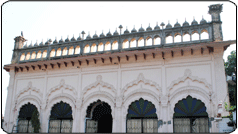Imambara of Zain-ul-Abidin Khan
The Nawabs of Awadh originally belonged to Iran which is well-known and acclaimed worldwide for its master calligraphers who excelled in Islamic calligraphy. The most beautiful inscription of Quranic verses on the Taj Mahal at Agra which is matchless in khat-e-thuluth is the work of Abdul Haque (titled Amanat Khan) who hailed from Shiraz in Iran. Yet, it is a pity that only few of the Nawabs of Awadh chose to decorate their religious buildings with Islamic calligraphy. Dargah of Hazrat Abbas appears to be the first in which the ruler's involvement resulted in the inscription of Quranic verses. It was done during the reign of Nawab Saadat Ali Khan (1798-1814) when he remodelled the shrine. Later his grandson, Naseer-ud-din Haider the second King (1827- 1837), employed calligraphic inscriptions for the superb decoration of the exterior as well as the interiors of the Imambara that was built for his foster son Kaiwan Jah at the Talkatora Karbala. Immediately thereafter, the third King Mohammed Ali Shah (1837-1842) splendidly incorporated calligraphy using specially designed forms of tughra for excellence in beautification of the facade of his Imambara Bahr-ul-Husnaat at Hussainabad ( popularly known as the Chhota Imambara). It is indeed the finest example of its kind, not seen anywhere else in the country.
Surprisingly, if it were just three rulers of Awadh who fancied calligraphy for their structures, we find at least double their number among the nobles and aristocracy who have extensively employed it for their religious buildings at Lucknow. One of the earliest amongst them was Mir Zain-ul-Abidin Khan of Nawab Asaf-ud-Daulah's period who built his Imambara and extravagantly decorated its interiors with tughra. Besides the common medallion design of tughra (formed in a circle) that is seen in most religious buildings, his Imambara has a* variety of rare designs of peculiarly fashioned tughra to depict the shape of a mosque or as a special treat, the shape of an oriental pagoda with its sloping roof on both sides. Such specimens may be seen here in good numbers. Traces of two triangular designs at the impost and three medallions including one in the middle on the intrados of the archways and specially formed tughras (in mosque or pagoda design) as facing panels on the pillars appear to be there in two sets of five intermediate archways that divide the Imambara into two large halls. [There is a shahnashin for placing the taazia and other iconic items. The shahnashin has pretty calligraphic designs which are there in the hemispherical arches. They are fashioned in the form of logos that fan out in five distinct radial segments provided in each arch].
Zain-u!-Abidin Khan, according to Shiv Prasad in Taareekh-e-Farah Bakhsh, was appointed the incharge of the district of Etawah and adjoining lands of do-aab (land between the rivers of Ganga and Jamuna) when Asaf-ud-Daulah annexed it from the Gosains during the early part of his reign. Najmul Ghani Khan Rampuri in Taareekh-e-Awadh mentions that Zain-ul-Abidin Khan, also known as Kauri wala (a nickname, was the deputy of llmas Ali Khan, the powerful khwajasara of Asaf-ud-Daulah and the contractor for collection of land revenue in the do-aab and western region of Awadh. He had amassed a lot of wealth and property. On his death in 1207 Hijri (1793) he left an estate valued at seventy lakh to his wife Misri Begum.
He also built an Imambara with a mosque at Bithoor (near Kanpur) on the banks of the river Ganga.
The Imambara of Zain-ulAbidin Khan inThakurgunj in the city is roof-less today. Only one of the three halls (the one on the South) is being maintained to some extent by an anjuman (a private organisation of Shia Muslims) but most of the building is almost crumbling. Ironically, the best of calligraphic specimens lie in the part where the plaster keeps falling off. Some complete tughra designs seen by the writer in 1992 appear broken and fragmented today, and whatever is left may soon vanish due to the vagaries of weather and decay of the original stucco plaster.
Organisations like INTACH (Indian National Trust for Art and Cultural Heritage) that speak so vehemently about the preservation of our artistic heritage, probablv don't account calligraphy as an art form. Why, otherwise, should such rare calligraphic specimens perish. Even the Archaeological Survey of India (A.S.I) in its protected monuments pays scant attention to such specimens and the State Archaeology Department appears totally indifferent to their preservation. The trusts and other organisations managing the affairs of these buildings hardly have any financial resources to maintain their buildings, what to say of preserving such rare and delicate art heritage as calligraphy.
Source:
Hindustan Times, City Scan, A Time in History
Wednesday 2.12.1998 — Imambara Zain-ul-Abidin Khan

